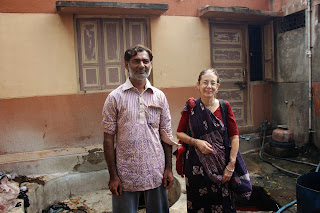Today we went to another village
about 20 minutes away to meet with Anwarbhai Khari, who is a Batik artisan and
former graduate of KRV.
If you (like me) have not heard
of Batik before let me give you my very uneducated - and I am sure overly
simplistic (but hopefully not disrespectful) overview of the process ...
Once they have determined the design, they use carved wooden blocks to put wax onto the material – this needs to be done superfast before the wax sets, so they have about 2 seconds to dip the block in wax and apply it in a perfect line with the one before it … and repeat.
This might sound easy, but this is a true ‘eye-mind-coordination’ challenge that I for one would fail at dismally! Then they dip the fabric in dye & crack the wax to allow some of the dye to penetrate to give it a spider-like effect that Batik from Kutch is known for. They then heat the fabric to remove the wax … and repeat the process with more wax and other colours of dye as necessary to complete the design.
Anwarbhai was fantastic and shared many great suggestions for what should be included in the course and things he would have found helpful when he started his business – his first word when we explained why I was here and what we were trying to do … “Necessary”.
 |
| Just another road warrior braving the traffic |
 |
| Anwarbhai & Judy Frater |
Once they have determined the design, they use carved wooden blocks to put wax onto the material – this needs to be done superfast before the wax sets, so they have about 2 seconds to dip the block in wax and apply it in a perfect line with the one before it … and repeat.
This might sound easy, but this is a true ‘eye-mind-coordination’ challenge that I for one would fail at dismally! Then they dip the fabric in dye & crack the wax to allow some of the dye to penetrate to give it a spider-like effect that Batik from Kutch is known for. They then heat the fabric to remove the wax … and repeat the process with more wax and other colours of dye as necessary to complete the design.
 |
Anwarbhai was fantastic and shared many great suggestions for what should be included in the course and things he would have found helpful when he started his business – his first word when we explained why I was here and what we were trying to do … “Necessary”.
Anwarbhai does not have a computer,
but uses his smart phone to conduct business via facebook, linked-in and other
social media portals. It has really
amazed me that virtually everyone I have met
has a mobile phone buried somewhere in their Sari or Kutri, yet many
have very little access to what I would consider fairly basic household items –
it really does go to show how important mobile technology is in connecting the
world!
The village was amazing, very
traditional shops next to ones selling ‘sponge bob’ backpacks and the most
amazing wooden doors just lined up against the wall … Nicole – if I could bring
them home they would be the perfect match for ones in the dining room table!
I gave Rama and his brother a
Tim-Tam today, and despite getting chocolate all over their fingers given the
heat, they were a big hit … was there every any doubt? They don’t speak English, but I think when
you go back for seconds and try and steal your grandfathers you know when you
have had a win!
Tonight, the female students and teacher
arrived for the class that starts tomorrow; I am looking forward to seeing the
traditional art in action!




































